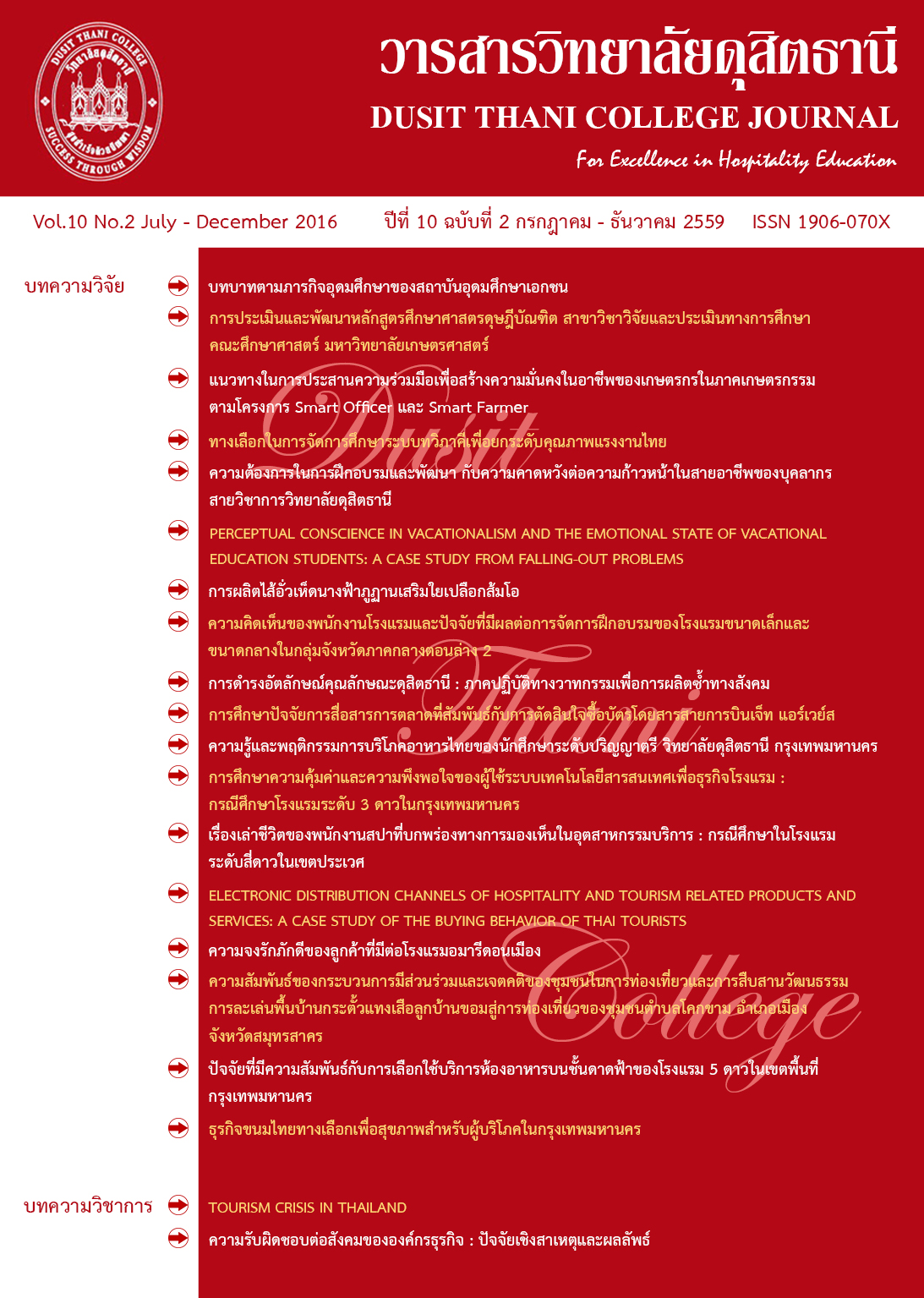ALTERNATIVE THAI DESSERT BUSINESS FOR HEALTH CONSCIOUS CONSUMERS IN BANGKOK
Main Article Content
Abstract
This research aims 1) to study the consumers’ behavior, attitude and decision making in choosing their best desserts, in the area of Bang-kapi District, Bangkok Metropolitan. 2) to develop Thai Desserts Healthy Alternatives for consumers update formulated using extracts of stevia instead of sugar, fat and sodium, which provides low calories consumption. 3) to make the ingredient of Thai Desserts Healthy Alternatives known to the general public and to promote a new way of healthy desserts consuming.
Questionnaire was used to collect data from 90 persons who were daily consumers of Thai desserts in Bang-kapi area. Analyses of the data was performed with statistical software and expressed in percentages, means and standard deviations.
The study showed that the behavior, attitude, and decision making of these consumers are based on the preferable of Thai desserts with herbal ingredients for the reason of their healthy properties. The expression in percentage was at ( = 4.75) As the study results reveal on that high percentage, the design for Thai Desserts Healthy Alternatives is definitely focus on their nutritional value to serve the health conscious consumers. The new ingredients that have been designed are for Somanus Homnil Crispy Grass Jelly and KeeMod The main ingredient for all is the use of the Stevia Extract instead of sugar. Thai herbs as well as cereals are also being used. The 90 persons who were given the questionnaire chose the new ingredients of Thai Desserts Healthy Alternative. The training and the appraisal performance were being given to the public and were attended by many people. The appraisal performance, however, has shown the higher percentage of receiving knowledge and understanding after the training. It was statistically measured at ( = 3.94).
Article Details
Article Screening Policy
- All research and academic articles to be published must be considered and screened by three peer reviews in the relevant field / article.
- All articles, texts, illustrations and tables published in the journal are the personal opinions of the authors. Editors don't always have to agree. And no responsibility whatsoever is the sole responsibility of the author.
- The articles to be published must never be published. Where did you first publish? And not in the consideration of other journals If the audit found that there has been a duplicate publication It is the sole responsibility of the author.
- Any article that the reader sees as being plagiarized or impersonated without reference. Or mislead the work of the author Please let the journal editor know it will be your greatest blessing.
References
กัลยา วานิชย์บัญชา. (2550). การวิเคราะห์สถิติ สำหรับการบริหารและการวิจัย. พิมพ์ครั้งที่ 10. กรุงเทพฯ: จุฬาลงกรณ์มหาวิทยาลัย.
คุณาสิริ เกตุปมา. (2548). ความรู้ทัศนคติ และพฤติกรรมการบริโภคอาหารเพื่อสุขภาพของประชากรในเขตกรุงเทพมหานคร. กรุงเทพฯ: จุฬาลงกรณ์มหาวิทยาลัย.
ชลลดา มงคลวนิช และ รัตนาภรณ์ ชาติวงศ์. (2556). “พฤติกรรมและภาพลักษณ์ตลาดน้ำในสายตาของเยาวชนไทย.” วารสารกระแสวัฒนธรรม. กรุงเทพฯ: มหาวิทยาลัยสยาม.
นงลักษณ์ สุขเอี่ยม และ วาสนา ชูหา. (2554). ปัจจัยที่มีความสัมพันธ์ต่อภาวะโภชนาการเกิน ของตำรวจภูธรเมืองชลบุรี. ชลบุรี: กรมอนามัย กระทรวงสาธารณสุข.
บรรจงลักษณ์ โพธิ์แก้ว. (2552). ขนมไทย. โครงการมหาวิทยาลัยไซเบอร์ไทย: สำนักงานคณะกรรมการการอุดมศึกษา.
ปาริสุทธิ์ สงทิพย์. (2550). การพัฒนาอาหารขบเคี้ยวชนิดแท่งจากข้าวกล้องและสมุนไพร. กรุงเทพฯ:มหาวิทยาลัยเกษตรศาสตร์.
พัทธนันท์ ศรีม่วง. (2555). อาหารเพื่อสุขภาพและโภชนบำบัด. โรงเรียนการเรือน มหาวิทยาลัยสวนดุสิต.
พันธวัช แดงพรหม และ โสมสิริ โชติโรดม. (2553). แป้งขนมขนมฟักทองสำเร็จรูป. ภาควิชาอุตสาหกรรมเกษตร. กรุงเทพฯ: สถาบันเทคโนโลยีพระจอมเกล้าลาดกระบัง.
วิภานี กาญจนาภิญโญกุล. (2545). ขนมไทยและพฤติกรรมการบริโภค: กรณีศึกษาตลาดดอนหวาย. กรุงเทพฯ: มหาวิทยาลัยธรรมศาสตร์.
ศรีสมร คงพันธุ์. (2550). ขนมและน้ำผลไม้. กรุงเทพฯ: แสงแดด.
สมศรี เจริญเกียรติกุล และคณะ.(2545). คุณค่าอาหารไทยเพื่อสุขภาพ. นครปฐม: สถาบันวิจัยโภชนาการ มหาวิทยาลัยมหิดล.
สำนักงานคณะกรรมการพัฒนาการเศรษฐกิจและสังคมแห่งชาติ. (2554). แผนพัฒนาเศรษฐกิจและสังคมแห่งชาติ ฉบับที่ 10 (พ.ศ.2550-2554). กรุงเทพฯ.
พระราชบัญญัติคณะกรรมการอาหารแห่งชาติ.(2551). การขับเคลื่อนยุทธศาสตร์ด้านความมั่นคงอาหารระดับประเทศ. กรุงเทพฯ: กระทรวงเกษตรและสหกรณ์.
ศันสนีย์ อุตมอ่าง. ผ2554). โครงการอบรมเชิงปฏิบัติการการผลิตทองม้วนเพื่อกระตุ้นเศรษฐกิจชุมชนตามแนวเศรษฐกิจพอเพียง. เพชรบูรณ์ : มหาวิทยาลัยราชภัฏเพชรบูรณ์.
ศิรินันท์ สิงห์สมาน และ นภาพร อุ่นศิวิไลย์. (2555). ขนมไทยแคลอรีต่ำ เพื่อคนรักสุขภาพ. ขอนแก่น: วิทยาลัยอาชีวศึกษาขอนแก่น.


